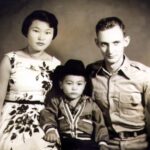The history of Korean international marriages can be traced back to various periods and circumstances.


Korea has a long history of interacting with neighboring countries, such as China and Japan, which led to intermarriage between Koreans and individuals from these regions. These marriages were often influenced by political alliances, trade relationships, and cultural exchanges.
The Korean War (1950-1953) played a significant role in shaping international marriages involving Koreans. The presence of foreign soldiers, primarily Americans, led to the phenomenon of Korean military brides, as discussed in the previous response.
In the latter half of the 20th century, South Korea experienced significant economic development, leading to increased labor migration and international marriages. Korean men often sought brides from neighboring countries, such as Vietnam, the Philippines, and China, due to factors like economic disparities, gender imbalances, and cultural preferences.
With the advancement of globalization and increased mobility, Korean international marriages expanded further. Korean men, particularly those living in rural areas or from lower socioeconomic backgrounds, sought brides from countries like China, Vietnam, the Philippines, and Cambodia. The motivations for these marriages varied, including economic reasons, the desire for a traditional wife, and the pursuit of love and companionship.
The Korean government implemented various policies and regulations to address issues related to international marriages, including concerns about human trafficking, marriage broker abuses, and cultural integration. These policies aimed to promote transparency, protect the rights of foreign spouses, and encourage cultural understanding.
